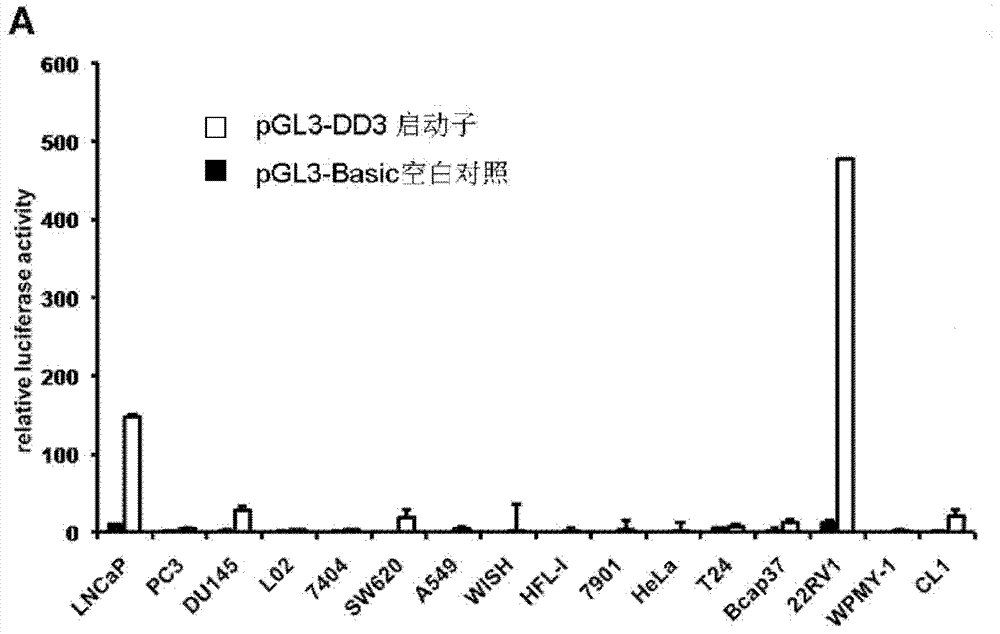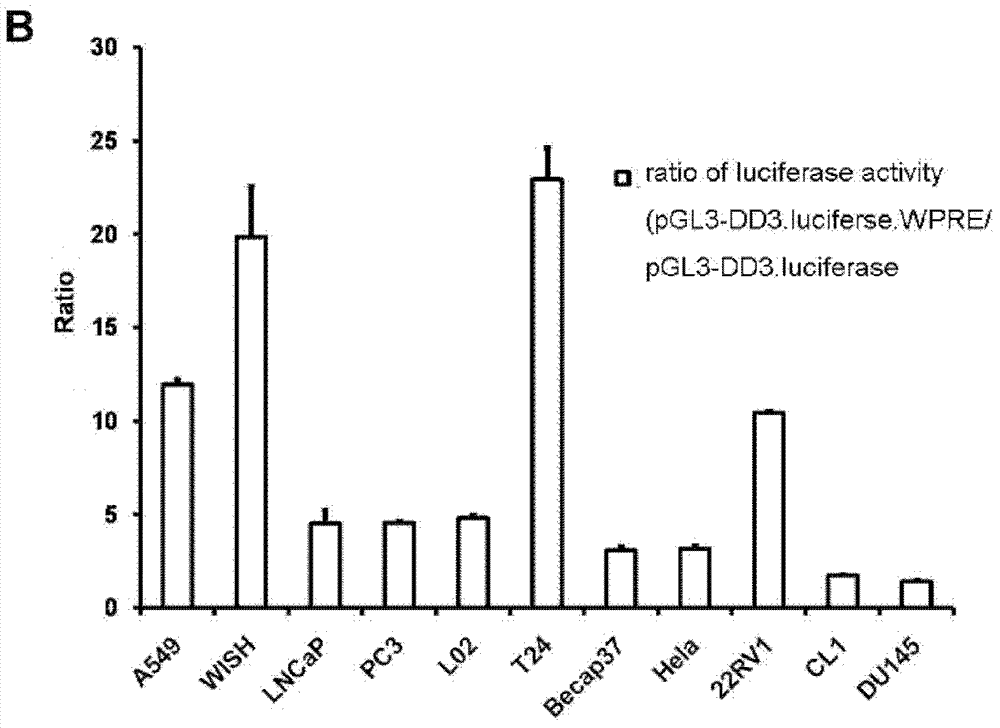Gene-viro-therapy medicine specific for prostate cancer
A prostate cancer-specific technology, applied in the direction of drug combination, gene therapy, genetic engineering, etc., can solve the problem of non-targeting and achieve high therapeutic effect
- Summary
- Abstract
- Description
- Claims
- Application Information
AI Technical Summary
Problems solved by technology
Method used
Image
Examples
Embodiment 1
[0032] Example 1: The activation ability of DD3 in various normal cells and cancer cells
[0033]DD3 (differential display code, 3) is located on chromosome 9 (9q21-22), with a total length of about 25kb, including 4 exons and 3 introns. DD3 is specifically highly expressed in human prostate cancer cells and metastatic necrotic foci, and is not expressed or lowly expressed in normal prostate and benign prostatic hyperplasia cells. The DD3 promoter is 215bp, and it can only function in prostate cancer cells to activate the expression of downstream genes (here E1A).
[0034] In this embodiment, the pGL-3 plasmid containing luciferase was used as the object, and the starting ability of the DD3 promoter in various normal cells and prostate cancer cells was investigated, as follows:
[0035] DD3 was cloned in front of the luciferase of pGL-3 plasmid to form pGL-3·DD3-Luciferase (pGL-3·DD3 for short), and the pGL-3 plasmid (pGL-3·basic) without DD3 was used as a control, According...
Embodiment 2
[0037] Example 2: Construction of pAd·DD3·D55-(PTEN)
[0038] 2.1, Ad5(WT) :Such as Figure 3A As shown, Ad5 (WT) is a wild type adenovirus 5 (Wild Type) adenovirus (Adenovirus, Ad, most of the Ad used now is type 5, but the word 5 is not specially marked), of which E1A is normal and E1B is normal;
[0039] 2.2, Ad·DD3·D55 : namely Ad·DD3·E1A·E1B (Δ55).
[0040] In the past, we have constructed Ad·E1A·E1B (Δ55), namely ZD55, which is an oncolytic virus, in which there is no change in E1A, and the 55KD gene in E1B is deleted (deletion), called D55, Z is the researcher's Surname Zou. ZD55 is the patent of this group, the patent number is ZL 021 57662.9 and 2005 1 0026151.5, its construction is unnecessary to repeat, it has anti-cancer effect, but non-specific to prostate cancer.
[0041] In order to construct a specific oncolytic virus in prostate cancer, E1A must be modified, and the natural promoter of E1A is replaced by a prostate cancer-specific promoter (DD3), becaus...
Embodiment 3
[0063] Example 3: Anticancer effect of Ad·DD3·E1A·D55-(PTEN) in vitro
[0064] Inoculate cancer cells and normal cells in 24-well plates (the number of cells is 5-10×10 3 ), when the cells grow to close to saturation (such as 80% saturation) (saturation means that the cells cover the whole hole). For different cells: including normal cells BEAS-2B, prostate cancer cells: CL1, 22RV1, DU145 and other cancer cells Bcap-37 (breast cancer), SGC-7901 (liver cancer), SW620 (colon cancer), BEL-7404 (liver cancer ), respectively treated Ad·PTEN, Ad·DD3 and Ad·DD3·D55-(PTEN) infection with the following different doses of virus (MOI).
[0065] Seven days later, stain with 2% crystal violet (dissolved in 20% methanol) for 15 minutes. After color development, observe the pathological changes of different cells. Live cells can be stained, dead cells cannot be stained, and all die without color.
[0066] The result is as Figure 4 shown. Depend on Figure 4 The results showed that all ...
PUM
 Login to View More
Login to View More Abstract
Description
Claims
Application Information
 Login to View More
Login to View More - R&D
- Intellectual Property
- Life Sciences
- Materials
- Tech Scout
- Unparalleled Data Quality
- Higher Quality Content
- 60% Fewer Hallucinations
Browse by: Latest US Patents, China's latest patents, Technical Efficacy Thesaurus, Application Domain, Technology Topic, Popular Technical Reports.
© 2025 PatSnap. All rights reserved.Legal|Privacy policy|Modern Slavery Act Transparency Statement|Sitemap|About US| Contact US: help@patsnap.com



